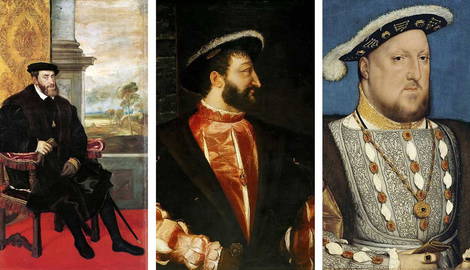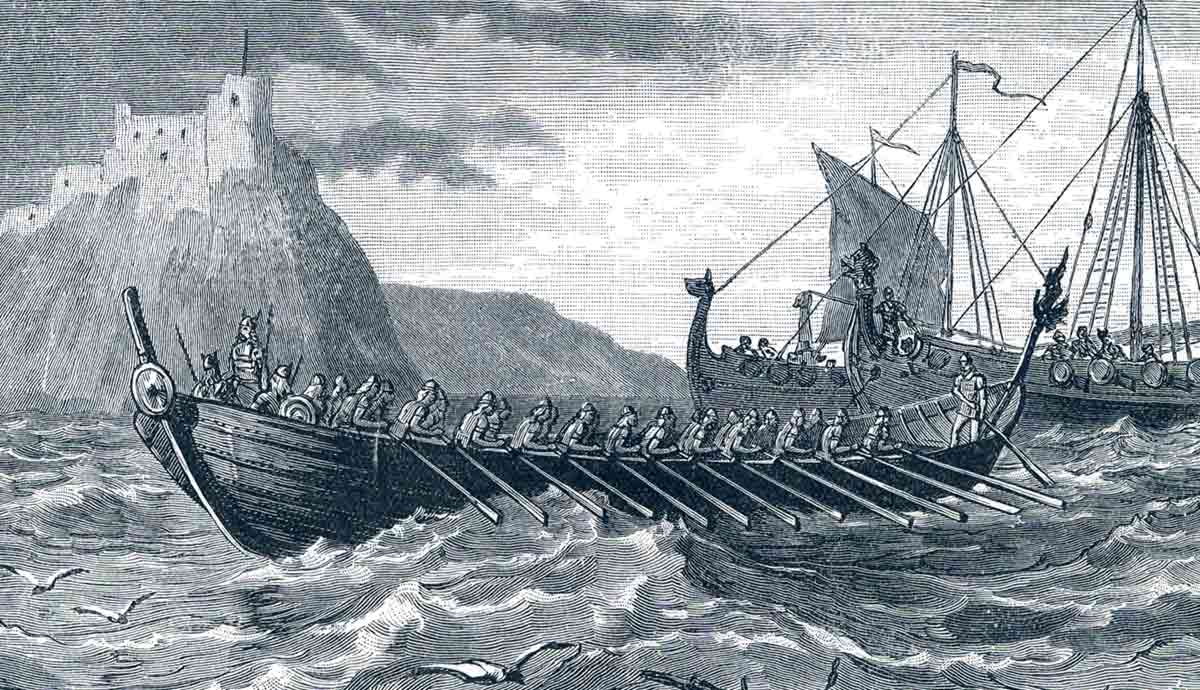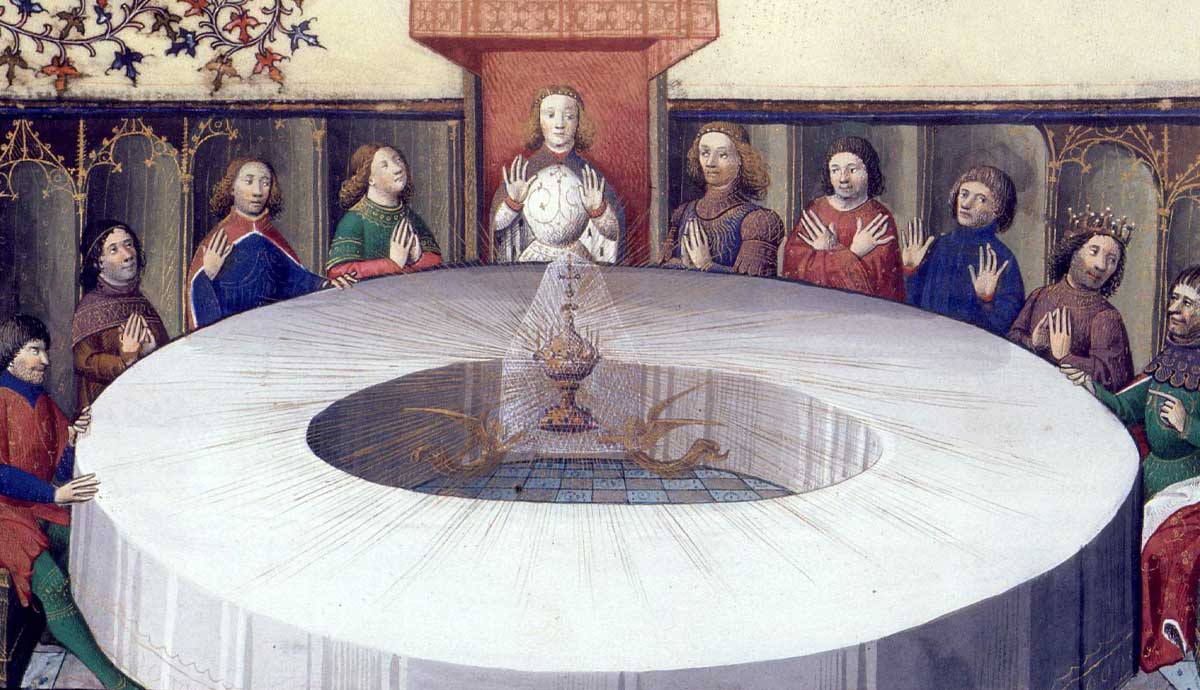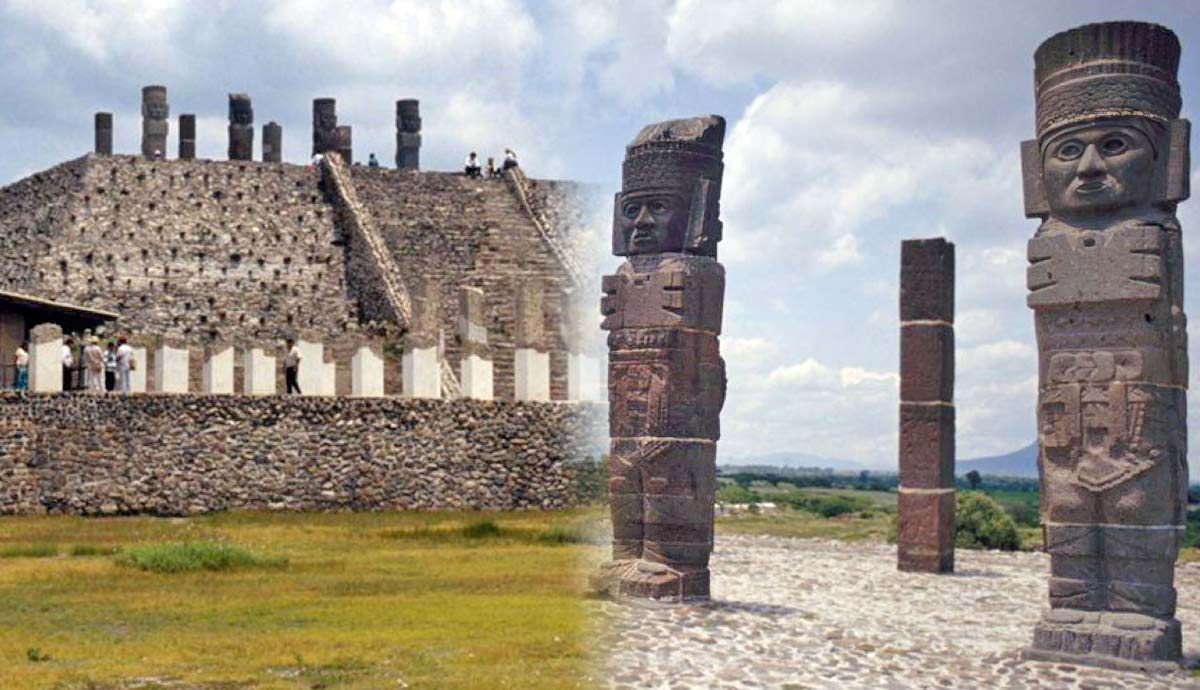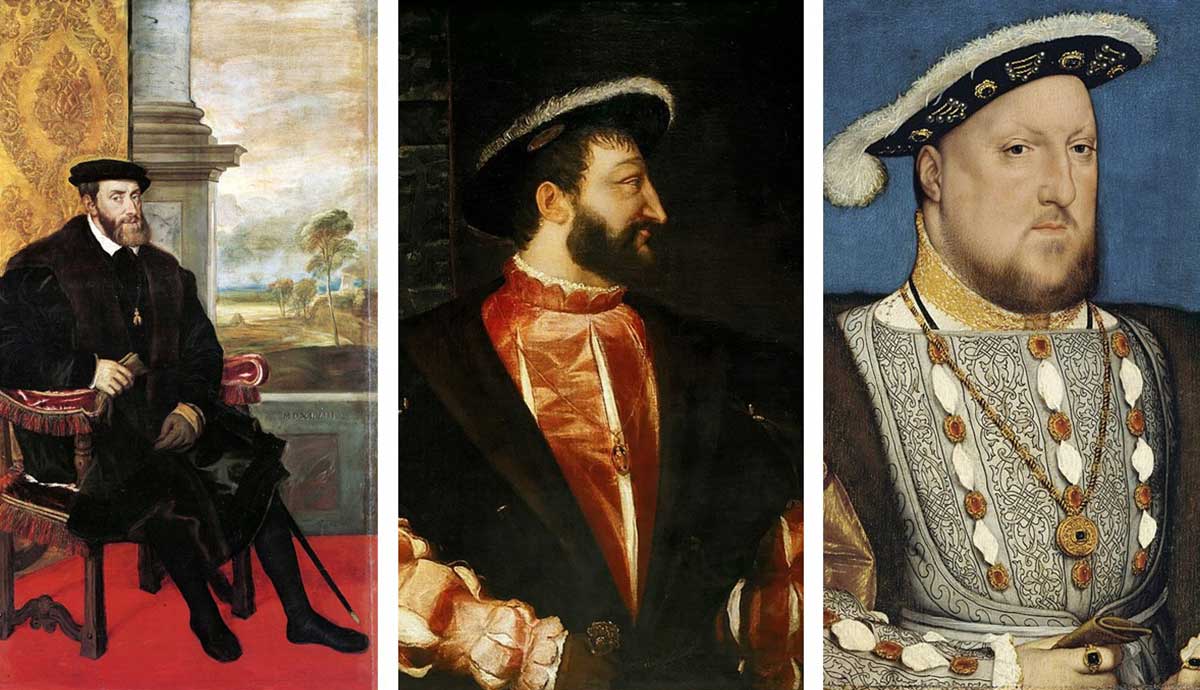
In an age when the exercise of power was largely personal rather than corporate, the machinations of and rivalry between three great monarchs (Charles V, Henry VIII, Francis I) could and did have an enormous impact on the events of the time. Nearly every war, alliance, scandal, or land swap that occurred in Western Europe in the first half of the 16th century involved some combination of these three men. Here we will take a look at a few of these interactions.
Charles V, Holy Roman Emperor and King of Spain

Born in 1500 to Philip “the Handsome” and Joanna “the Mad,” Charles V would grow up to inherit a vast and diverse congeries of land, unparalleled in European history, including the Netherlands, Spain, various territories in Italy, and the Spanish colonies in the Americas.
After being elected Holy Roman Emperor in 1519 (the votes for which cost him a staggering amount of money), he controlled lands and resources on a scale far beyond any other monarch in Europe, perhaps rivalled only by the Ottoman sultan. However, these far-flung holdings involved him in nearly every political situation that developed in Europe during his reign, and his machinations involved nearly every other ruler of the age on some level.
His main rival was Francis I of France, against whom he fought in Italy during the Italian Wars and elsewhere. He had no scruples about allying with Henry VIII of England against France or thwarting Henry’s ambitions as it suited his needs. But despite the seemingly endless political intrigues in which he was engaged, Charles always saw himself as the rightful defender of Christian Europe, whether against heretic Protestants or the infidel Ottomans.
Charles and Henry

In August 1521, just over a year after Henry VIII and Francis I had so grandiosely expressed their eternal amity at the Field of the Cloth of Gold (see below), Charles V and Henry VIII signed a secret anti-French alliance known as the Treaty of Bruges. The terms of this agreement required Charles and Henry to commit significant military forces, both on land and at sea, to a joint attack on Francis I no later than 1523. To further cement the alliance, Charles was to marry Henry’s daughter, Mary (as this did not come to pass, however, Charles’s son Philip eventually did marry Mary).
Although England did engage in some small-scale military activity in France, the joint invasion never came to fruition. After France was soundly defeated at the Battle of Pavia in 1525 and Francis found himself the prisoner of Charles (see below), Henry became worried about Charles’s seemingly unstoppable successes. The balance of power was becoming unbalanced. After Francis’s release from imprisonment under the terms of the Treaty of Madrid (1526), he quickly set about forming an alliance against Charles, which became known as the League of Cognac.
Although Henry did not join the League, he did give it his tacit approval and went on to formally ally with France against Charles after the sack of Rome by Imperial troops in 1527. The back-and-forth nature of these machinations would characterize relations between Charles V and Henry VIII throughout their reigns.
Charles and Francis

In September 1544, after a joint assault on France by Charles V and Henry VIII (they were once again on good terms), the Treaty of Crépy was signed by Franis I and Charles V. Francis agreed to vast territorial concessions, but Charles also agreed to return the significant gains he had made on French soil.
One might ask why Charles, after decades of intermittent warfare against Francis, would give up such prizes. However, Charles, consistent with his self-image as protector of Christendom, had a two-fold purpose in agreeing to the treaty. Firstly, he sought to unite the Christian kingdoms of Europe against the growing power of the Ottomans, who had been steadily advancing in Hungary (especially after the Battle of Mohacs in 1526) and the Balkans. A weakened and hostile France could not be counted on for support against the Ottoman Empire.
Secondly, peace with France freed Charles’s hands to deal with the spread of Protestantism in his German-speaking lands (Protestantism had never spread very widely in Spain). In the treaty, Francis also agreed to aid Charles in the suppression of heresy. This suited Francis as well, as Protestantism, especially Calvinism, was already making serious inroads in predominantly Catholic France. Thus, Charles found ways of dealing with Francis which, at least theoretically, balanced his various interests and ambitions.
Francis I, King of France

Francis I, cousin of the previous king, Louis XIII, ascended to the throne of France in 1515, at the age of 21. Before Charles V accumulated his vast territories in the following years, Francis could rightly claim to be king of the most powerful realm in western Europe. A military man of action with a head full of chivalric ideals, he enthusiastically dove into the Italian Wars, which had raged intermittently since 1494, winning a stunning victory at Marignano in his first year on the throne. However, he could also be quite Machiavellian, as evinced by his scandalous alliance with the Ottoman Turks, when he went so far as to allow an Ottoman fleet to use a French port.
Francis’s primary enemy throughout his reign was Charles V, whose lands nearly surrounded France. But he could never ignore the threat from the north either, as Henry VIII of England saw Francis as his primary enemy.
Francis and Henry

As was the case with several of his royal forbears, one of Francis I’s main strategies for dealing with England was to force the English to look both south and north by allying with and supporting Scotland, England’s traditional enemy. This was accomplished primarily through marriage alliances revolving around the powerful Guise family.
In 1537, Mary of Lorraine (Guise) married King James V of Scotland, tying Scotland closer to France. Their child, Mary (“Queen of Scots”), inherited the Scottish crown, making her an extremely valuable asset to both Francis I and Henry VIII. The Treaty of Greenwich (1543) between England and Scotland stipulated that Mary would marry Henry’s son Edward. However, when the Scots repudiated this agreement, it led to England laying waste to the lowlands in what became known as “The Rough Wooing.”
Mary was eventually brought to France, where she was raised at court, marrying Francis I’s grandson, Francis, who became King Francis II in 1559, making Mary queen of both Scotland and France. Francis’s plans to bring France and Scotland into a lasting alliance ultimately came to naught, as Francis II lived less than a year as king, and upon her return to Scotland, Mary wasted little time in alienating her subjects, ultimately resulting in her flight to and imprisonment in England.
Francis and Charles

At the Battle of Pavia in 1525, France suffered perhaps its worst defeat since the Battle of Agincourt over 100 years earlier. This was another battle in what came to be known as the Italian Wars (1494-1559), which were fought primarily between the French Valois dynasty and the German/Spanish Habsburg dynasty.
The Battle of Pavia was particularly disastrous for the French—beyond the sheer loss of life, including many nobles—because Francis I himself was taken prisoner. Initially imprisoned in Italy, he was eventually transferred to Spain, where Charles V pressured him to accept crippling terms in order to secure his release. Ultimately, Francis agreed to Charles’s terms in the Treaty of Madrid in January 1526. France was to renounce its claim to various lands, especially in Burgundy, as well as a slew of other stipulations. To guarantee Francis’s good faith, two of his sons would be held captive by Charles V until the treaty was ratified in France.
However, upon returning to France, Francis wasted no time in repudiating the terms, leading to the absurd situation wherein Emperor Charles actually challenged Francis to a duel as a matter of honor. By releasing Francis before the terms of the treaty were fulfilled, Charles missed an opportunity to perhaps bring the Italian Wars to a much earlier conclusion. But one of Francis’s sons, the future King Henry II, never forgot his time as Charles’s prisoner and bore a grudge until the emperor’s death.
Henry VIII, King of England

Although associated in the popular imagination mostly with his six wives and their varying fates, there is much more to the story of Henry VIII. Neither destined nor educated to be king (his brother Arthur was heir to the throne until his untimely death in 1502), Henry VIII succeeded to the English throne in April of 1509, becoming only the second king of the Tudor Dynasty, created after Henry’s father, Henry VII, defeated Richard III at the Battle of Bosworth and subsequently married Elizabeth of York, thus uniting the houses of York and Lancaster and (it was intended) ending the Wars of the Roses.
Henry VIII was aware, as was his father, that the Tudor Dynasty was still on shaky ground and that at any moment another claimant to the throne could appear and launch a campaign to usurp the kingship. He was also aware that of the three great monarchs of the time, he ruled over the weakest kingdom, and thus strove to strengthen England (especially its navy) and to insert himself, often as a sort of wild card, into the power politics of the continent.
Henry and Francis

By far the most famous event involving Henry VIII and Francis I has gone down in history as the Field of the Cloth of Gold. For over two weeks in June of 1520, Henry and Francis, as well as most of their courts, met at a field outside of Calais for an unthinkably expensive series of tournaments, banquets, and entertainment, intended by both monarchs to overawe and impress the other with their magnificence. The number of tents bedecked with cloth of gold gave the event its name, and also gives an idea of its lavishness.
The two kings sought to outdo each other in chivalric courtesy, gift-giving, praising each other’s qualities, and generally showing off their extreme wealth. Promises were made of eternal amity between the two, even though Henry was already negotiating an alliance with Charles V—the archenemy of Francis—and Francis was already scheming to renew and strengthen the “auld alliance” between France and Scotland—Henry’s enemy to the north.
In less than two years, England and France were once again at war, but the legendary extravagance of the Field of the Cloth of Gold is remembered as one of the most iconic events of the 16th century.
Henry and Charles

Although Henry VIII played no role in the Imperial sack of Rome in 1527, the event had indirect but serious repercussions for England. The unplanned attack on Rome by Charles V’s army put Pope Clement VII firmly under the power and influence of Charles. The timing of this could not have been worse for Henry, who soon sought a way to divorce his wife, Catherine of Aragon, so that he could marry his new favorite, Anne Boleyn. Only the pope could grant such a dispensation (which was not unheard of). However, Catharine of Aragon was the aunt of Charles V and, not wanting to see his aunt abandoned and also not wanting to offend his Spanish subjects, Charles used his influence over Pope Clement VII to ensure that the divorce did not occur.
With no option left within the church, Henry took the drastic step of separating England from Rome, thus securing his much-desired divorce and laying the foundations for the autonomous Church of England. Thus Charles V was unintentionally a major contributor to Henry’s break from Rome (which would have horrified Charles if he could have seen the future).
Impact on the Rest of the 16th Century

The political maneuverings of Charles V, Francis I, and Henry VIII set the stage for the second half of the 16th century. Francis I and Henry VIII both died in 1547, and Charles V died in 1558 after abdicating in 1556. The Italian Wars, which had consumed so much of Charles’s and Francis’s time and resources, finally came to an end with the Treaty of Cateau-Cambresis in 1559. When Charles abdicated in 1556, his lands and titles were divided between his son, who became King Philip II of Spain, and his brother Ferdinand, who became Holy Roman Emperor.
France would be plagued by religious strife for much of the rest of the century. After Henry VIII’s death, England had its own share of religious strife as the pendulum between Catholicism and Protestantism swung back and forth during the short-lived reigns of Mary I (“Bloody Mary”) and Edward VI, before stability was gradually reestablished during the reign of Elizabeth I.
The pattern of secret treaties and shifting alliances that typified the era of Charles V, Francis I, and Henry VIII would continue throughout the 16th century and into the next, right up until 1618 and the outbreak of the Thirty Years War, which would drastically reshape the European political landscape.
